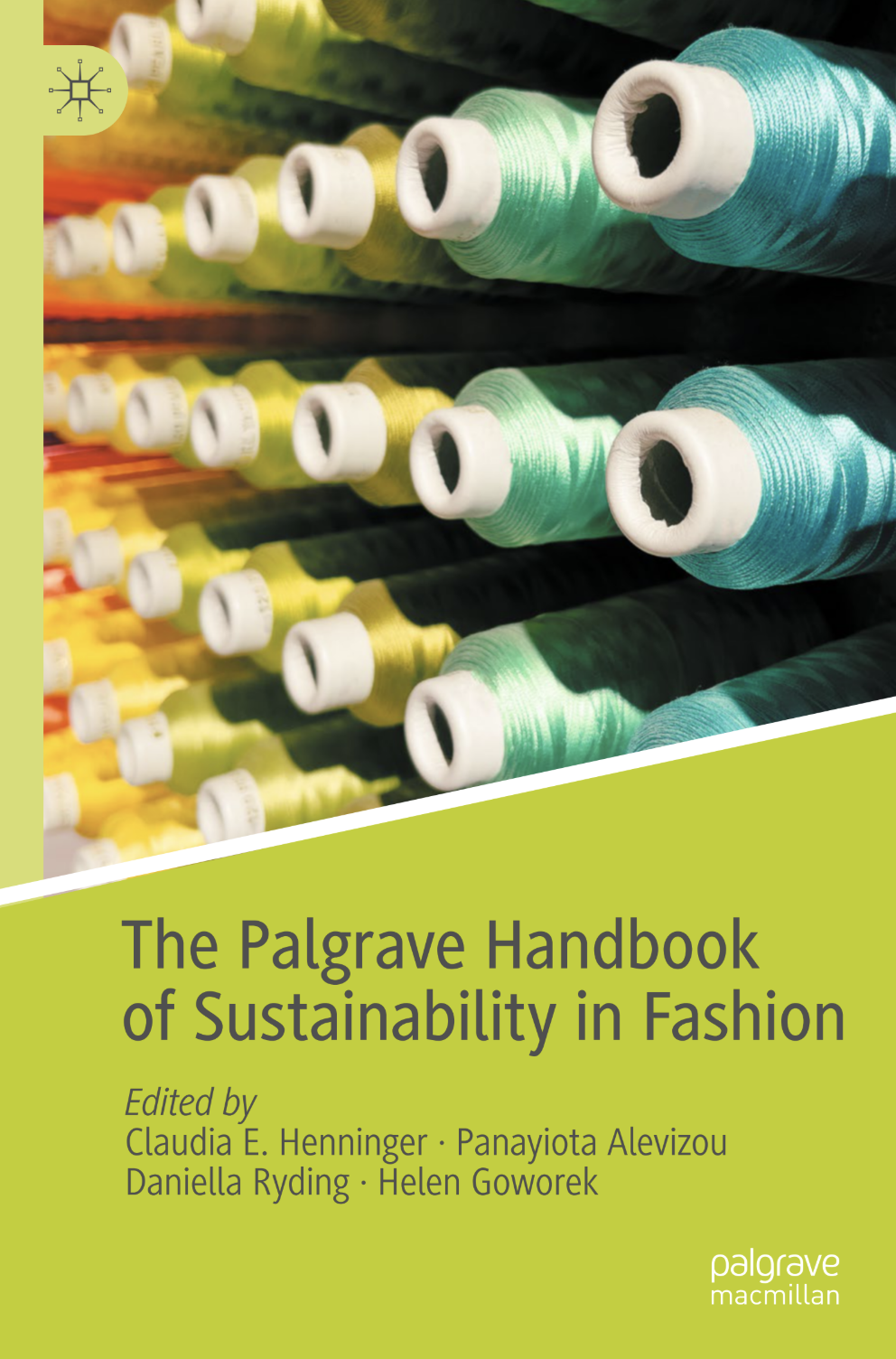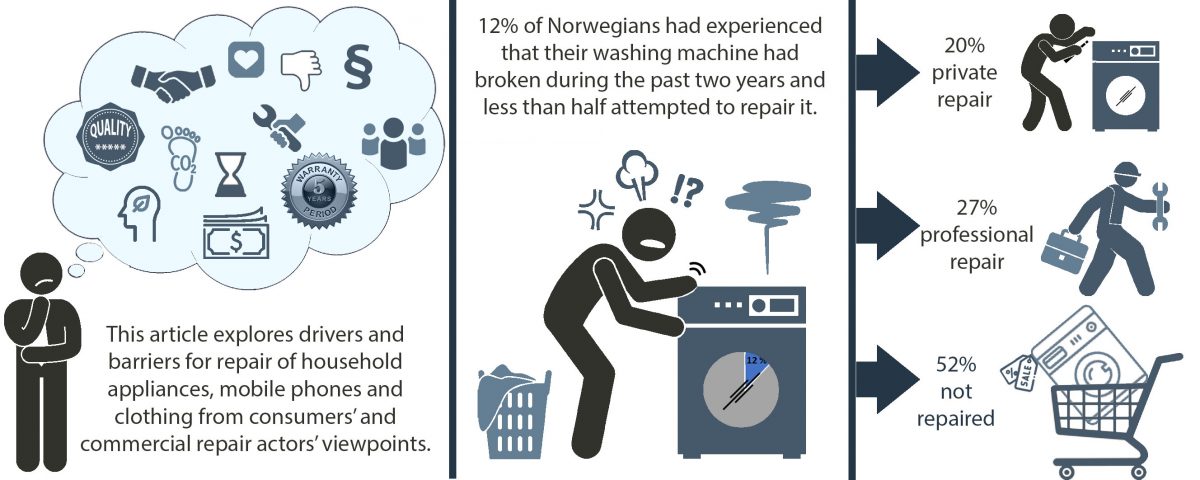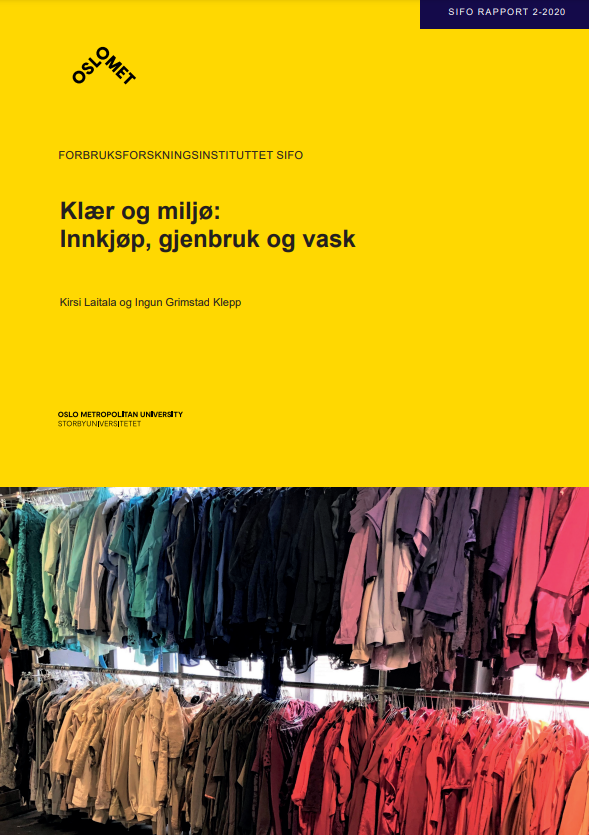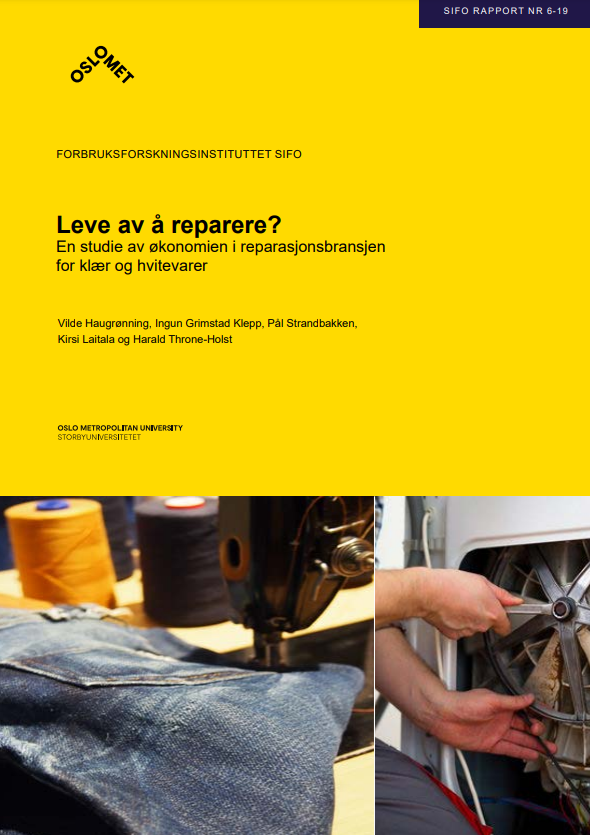Vilde Haugrønning, Ingun Grimstad Klepp, Pål Strandbakken, Kirsi Laitala og Harald Throne-Holst
Sammendrag
Rapporten undersøker reparasjonsbransjen for klær og hvitevarer og aktørenes synspunkter på barrierer og muligheter for utvikling av tjenestene. Det er viktig å få en bredere forståelse for hvilke muligheter og barrierer de opplever i sitt arbeid med reparasjon, fordi dette kan være en viktig del av sirkulær økonomi og bærekraftig forbruk. De aller fleste reparasjoner foregår privat, og forbrukernes holdninger er også viktige for bransjen. Derfor har vi trukket forbrukernes oppfatninger inn i analysen basert på en spørreundersøkelse. Rapporten diskuterer dermed ikke bare hva som kan styrke en bransje, men også hva som kan bidra til at flere produkter blir reparert og dermed brukes lenger.
Den første delen av rapporten er en litteraturgjennomgang. Vi presenterer tidligere studier av bransjen i Norge, samt svenske erfaringer med redusert merverdiavgift. Videre følger en analyse av 15 kvalitative intervjuer med aktører i reparasjonsbransjen, 10 innen klær og 5 innen hvitevarer. I analysen har vi også inkludert datamateriale fra spørreundersøkelsen med forbrukere. Reparasjonsbransjen er svært sammensatt og består delvis av store bedrifter hvor reparasjon er en forsvinnende liten del av deres virksomhet, og av små enmanns bedrifter hvor reparasjon kan være, men ikke alltid er en viktig del av virksomheten. Likevel er det flere likhetstrekk for hva som er barrierer og muligheter for bransjen. Blant barrierer finner vi at den gjennomgående lave prisen på produkter og lav kvalitet bidrar til liten lønnsomhet for reparasjoner, og det er svært liten betalingsvilje blant forbrukere for reparasjonstjenester. Videre er tilgangen på kompetent personale en stor utfordring, som forventes å bli større i årene fremover.
Mulighetene ligger i potensielle samarbeid mellom tilretteleggere og tilbydere for reparasjoner, og spre kunnskapom reklamasjon og rettigheter ved kjøp av varer. Både bransjen og forbrukerne er enige om at bedre kvalitet på produkter er et utgangspunkt for økt produktlevetid, og dette vil også øke antall lønnsomme reparasjoner. I tillegg ser vi også et behov for at mindre bedrifter som tilbyr tilpassede produkter og ulike tjenester som forlenger produktlevetiden, får økonomiske tilskudd slik at de blir mer rustet til å bidra i overgangen til et mer miljøvennlig forbruk.
Klikk her for å lese hele rapporten (oda.oslomet.no).
Summary
This report explores repairs services for clothing and white goods by looking at financial aspects and drivers and barriers for service development. It is important to gain a broader understanding of the drivers and barriers experienced by actors in repair work, as this can be an important part of the circular economy and more sustainable consumption. The vast majority of repairs are private, and consumer attitudes are important to this industry. Therefore, we included consumer perceptions in the analysis based on a national representative survey in Norway. The report discusses not only what can strengthen the repair industry, but also how more products can be repaired and used longer.
The first part of the report is a literature review. We present previous studies of the industry in Norway, as well as Swedish experiences with reduced value added tax. Furthermore, an analysis of 15 qualitative interviews with actors in the repair industry follows, 10 in clothing and 5 in white goods. In the analysis, we also included data from the consumer survey. The repair industry is very complex and partly consists of large companies where repair is a small part of their business, and of small one-man businesses where repair can be, but is not always, an important part of the business. Nevertheless, the barriers and facilitators for the industry are often similar. Among barriers, we find that the consistently low price of products, and low quality, contribute to low profitability in repair work, and there is very little willingness to pay among consumers for repair services. Furthermore, access to competent staff is a major challenge, which is expected to increase in the years ahead.
The drivers lie in potential collaboration between repairers and providers of repair, and dissemination about complaint and warranty rights when purchasing goods. Both the industry and consumers agree that better quality of products is a starting point for increased product lifespans, and this will also increase the number of profitable repairs. In addition, we also see a need for smaller companies that offer customized products and various services that extend their product life to receive financial grants so that they are more equipped to contribute to the transition towards more sustainable consumption.



